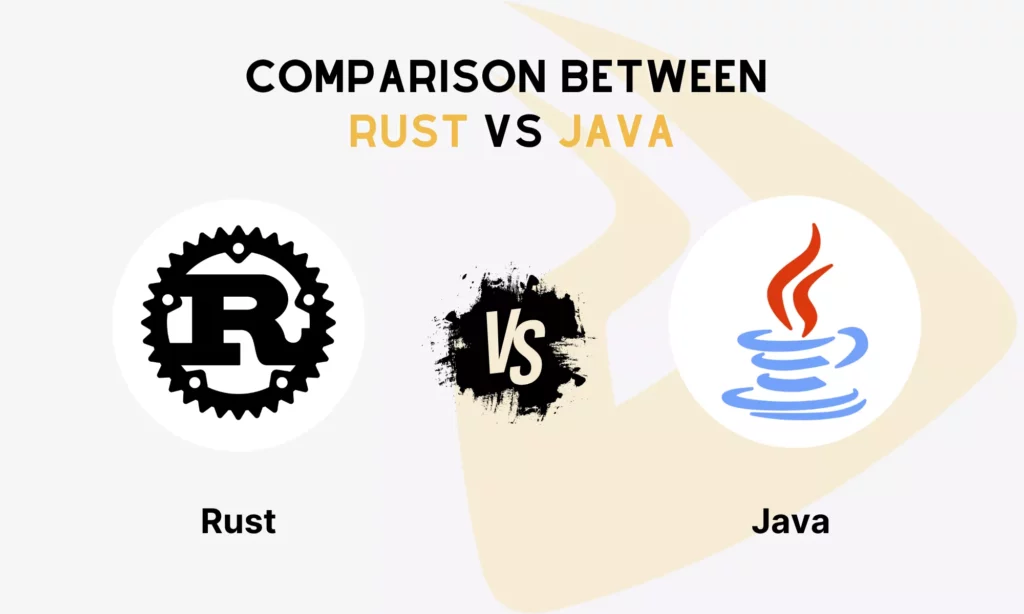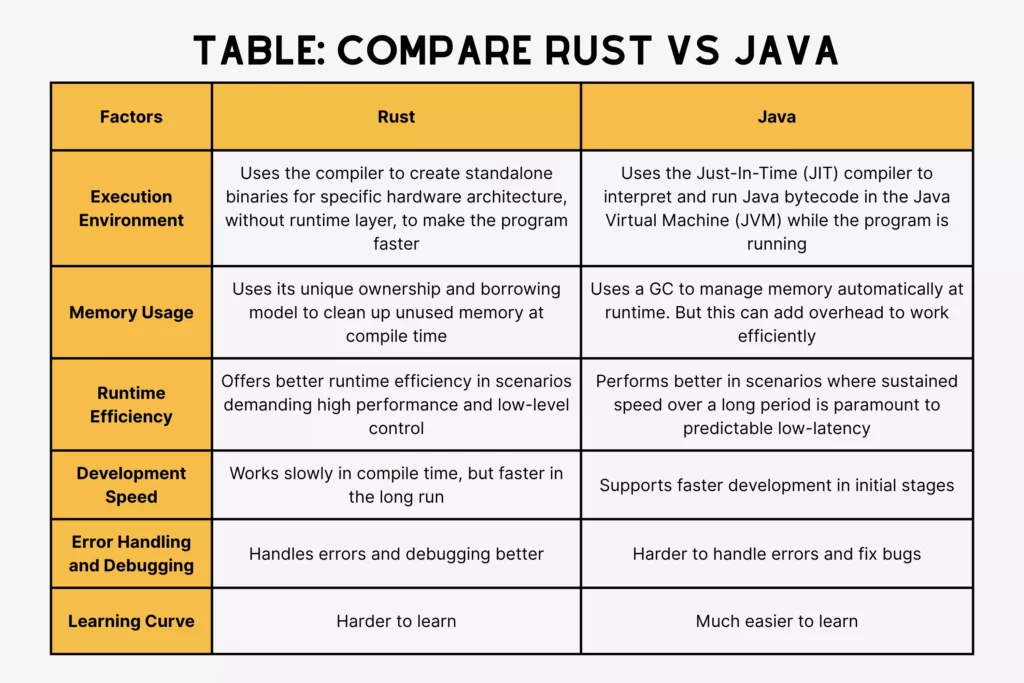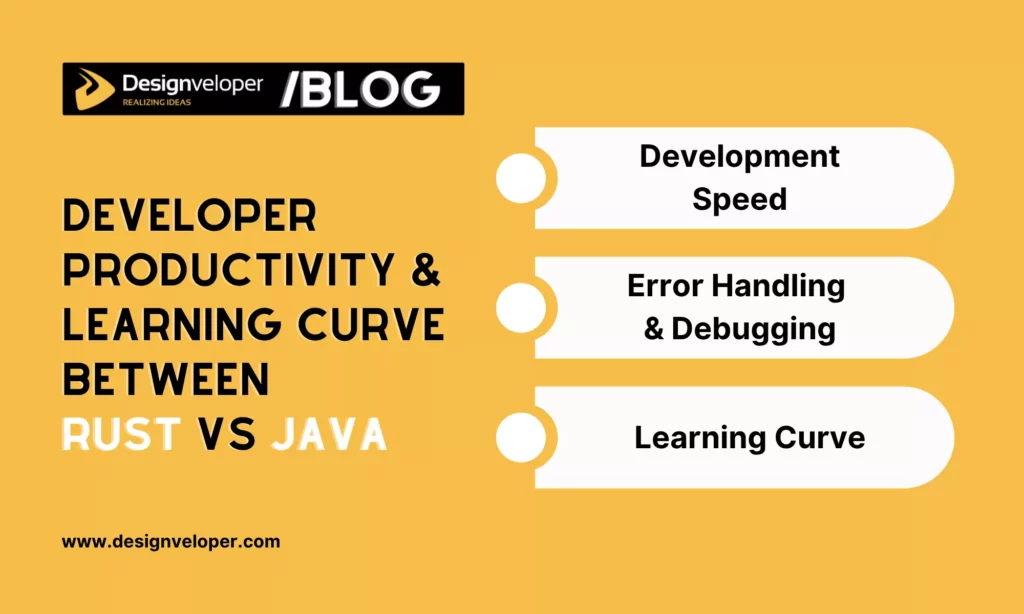You’re looking for the right tech for your project, right? But still hesitate between Rust vs Java? So, to ease your finding, we will really pit these two languages against each other and dig into where these languages truly shine.
We’re not only looking at their performance and technical stuff, but also finding out how they boost developer experience. Keep reading and learning about their key differences!

Understanding Rust and Java
Okay, now, don’t rush to find out about how different Rust and Java are. Let us walk you around what each means first.
Java is probably what most people are familiar with. So we’ll start with it first.
Java is an object-oriented language. Its design philosophy is all about managed, high-level control.
The entire ecosystem is built around the JVM. It stands for Java Virtual Machine and it does a ton of heavy lifting for you.
The biggest, most obvious feature of Java is Garbage Collection (GC).
When you allocate memory in Java, you don’t actually have to worry about freeing it yourself. The GC is running in the background, keeping an eye on things, tidying up the heap when it decides it’s time.
Modern JVMs have made huge, massive strides here. Over time, Java grew into one of the most widely used programming languages in the world (29.4%). It has an ocean of libraries, frameworks, and tools, including Spring Boot – the most important backend dev skill. The language powers everything from enterprise systems to Android apps.
Now, switching to Rust. Rust is, well, a systems programming language. It gives you that low-level control, the kind C and C++ developers wield, but without the terrifying risk of memory errors.
Instead of a runtime GC, Rust checks memory safety at compile time. When you write Rust code, the compiler enforces a set of rules—who owns the data, and who is just borrowing a reference to it.
If you try to write code that could lead to a race condition, the compiler will just straight-up say, “Nope! Not today,” and refuse to build.
This is what gives Rust its edge in minimal resource usage.

Rust vs Java Performance Comparison

You understood what Rust and Java are? Great! Now, we’ll move to talk about how they perform differently.
Execution Environment
The first major difference lies in how they actually run the code.
We call Rust a compiled language. You hit ‘compile,’ and the Rust compiler churns out a standalone binary tailored for your specific operating system and hardware architecture.
There’s virtually no runtime layer; just your code runs right on the metal. So you know, this makes the program work blazingly fast and has a minimal initial memory footprint.
Java, on the other hand, operates within the Java Virtual Machine (JVM). You compile Java code into bytecode, which the JVM then interprets and runs.
Now, the JVM uses a Just-In-Time (JIT) compiler. This compiler dynamically profiles the running code and compiles frequently executed sections into native machine code while the program is running.
The JIT can make optimizations that a static compiler can’t. So, it leads to incredible sustained performance. For this reason, Java sometimes even outperforms natively compiled languages for long-running processes.
But the downside? Startup time is typically slower because the JVM has to spin up, load classes, and then spend time ‘warming up’ the JIT compiler to reach its peak speed.
Memory Usage
Rust gives the developer direct control over memory. It uses a unique ownership and borrowing model enforced at compile time. This system essentially guarantees memory safety without needing a Garbage Collector (GC).
When an object’s owner (aka a variable) goes out of scope, the memory is deallocated immediately and deterministically. This granular, precise control means Rust programs generally have a much smaller and more predictable memory footprint.
There’s no extra memory needed for a GC to work with, no large heap reserved upfront, and no floating garbage hanging around. If you’re building something for an embedded system, or an environment where resources are super tight, Rust seems to be the obvious choice here, really.
Java relies on a GC to manage memory automatically. This is a massive win for developer productivity, as you don’t have to worry about manual allocation and deallocation.
However, a GC does introduce overhead. It needs extra memory to work efficiently, and it has to do work at runtime to track down and free unused objects.
Even with modern, highly-optimized GCs like ZGC or Shenandoah, which are honestly technological marvels, there’s always the potential for ‘GC pauses.’ These are those unpredictable, if brief, moments where the application stops or slows down while the GC catches up.
For high-throughput, latency-sensitive systems (like maybe a financial trading platform or a real-time game server), that non-deterministic pause is a critical concern, you know?
Runtime Efficiency
Rust wins for workloads that demand consistent, low-latency performance. It compiles to native code and completely bypasses the GC. So its performance is highly deterministic.
Rust is similar to C/C++ in some point. So it often performs as well as these languages, especially in benchmarks involving low-level system tasks, heavy I/O, or CPU-bound computations.
Plus, its approach to concurrency allows for very efficient parallel processing. It also prevents data races at compile time.
Java excels in high-throughput, enterprise-scale applications where sustained speed over a long period is more important than predictable low-latency.
Once the JVM’s JIT compiler has ‘warmed up’ and optimized the hot paths, Java can be very fast. It often handles a vast number of small object allocations very efficiently due to its GC model.
But for applications where the process is short-lived, or where a cold start needs to be lightning-fast (think serverless functions, for example), Java’s initial overhead means it might lose the race.
Developer Productivity and Learning Curve

Well, comparing programming languages does not just rely on their technical stuff, right? Their learning curve and developer experience are equally crucial.
Development Speed
You can say Java supports faster development than Rust in initial stages. Let’s say it’s because Java has been around the block, what, two decades now?
It has a massive, mature ecosystem of libraries, frameworks, and tools. Such stuff lets you create complex business logic almost instantly and be off to the races in a few minutes. Spring Boot, Hibernate, Apache Struts, etc. you can call a lot.
Its “write once, run anywhere” promise, coupled with its simple, object-oriented structure, also enables rapid iteration. Java definitely boosts your development, especially in the early stages of a project or in the enterprise space where you’re mostly moving data around.
Rust, by contrast, well, can feel like you’re trying to build a finely-tuned Swiss watch from scratch.
The compile times can be noticeably slower, particularly for large projects, which definitely breaks your flow.
But here’s the subtle bit most people miss: The slow-down in development speed is mostly front-loaded. You spend more time wrestling with the borrow checker and getting the types just perfect. But once the code does compile, you’re pretty much set.
That compile-time struggle is actually an investment that prevents a whole avalanche of runtime bugs, and that, in the long run, really speeds things up.
Error Handling and Debugging
This is where Rust shines like a beacon, in our professional opinion.
Rust’s error handling philosophy focuses on explicit, non-nullable types like Option and Result to address all possible failure cases.
The compiler practically yells at you, “Hey, what if this file isn’t found? You need to deal with that!” It’s rigid, yes, but that rigidity eliminates entire categories of common bugs.
Remember those dreadful, soul-crushing Null Pointer Exceptions that plague Java codebases? Those are pretty much non-existent in Rust.
And Java? Well, it handles errors primarily through exceptions. This mechanism basically stops your program in the middle and lets you separate error handling from the main codebase.
This can, and often does, lead to production-level chaos where an unhandled exception just blows up your application at the worst possible time.
Plus, debugging Java in a production JVM can be a bit of a nightmare. Trying to figure out why the garbage collector is thrashing or why a subtle race condition is only happening once a week is a deep, dark rabbit hole.
It seems like Java lets you write your code easily, but then punishes you with runtime bugs. While Rust makes writing hard, but then gives you peace of mind at runtime.
Learning Curve
“Which one is easier to learn: Java or Rust?” you may ask.
If your team is already steeped in C, C++ or C#, jumping into Rust and Java is basically a gentle stroll. The concepts are familiar.
But many still say Java is much easier to learn than Rust. Its syntax is simpler, the tooling is ubiquitous, and the documentation is boundless.
You can find a Stack Overflow answer for literally any Java question you have. It’s a low barrier to entry.
Rust is a bit steep. The ownership model and the borrow checker are completely alien concepts to many developers, especially those coming from managed languages like Java or Python.
It requires a fundamental shift in how you reason about data and memory. It’s a paradigm shift, not just a syntax change.
New users often spend days fighting with the compiler, desperately trying to satisfy the borrow checker. It’s frustrating, it can feel like you’re hitting a brick wall over and over again.
Honestly, it might take a Java developer six months of dedicated effort to become genuinely proficient in Rust.
That said, once they clear that initial hump, developers often report feeling a huge sense of empowerment, suddenly understanding system internals with a crystal clarity that the JVM kind of abstracts away.

When you’re trying to decide between Rust and Java for a major project, you really need to lift your gaze beyond just the language syntax and those, you know, flashy performance benchmarks. Because, frankly, the ecosystem is often the make-or-break factor.
Now, we’ll look at which tools, libraries, and community support each offers.
Java’s ecosystem has been building for over twenty-five years. It is enormous, almost impossibly so.
The sheer volume of mature tools like Spring and Hibernate handles almost any conventional business problem for you. Building a web service, integrating with a CRM, or processing payments – Java lets you piece together a solution incredibly quickly.
And don’t forget the IDE experience – IntelliJ IDEA for Java is. The code completion, the refactoring tools, the debugger – it offers an incredibly seamless environment that just works right out of the box.
Java also has a vast, deep, and corporate-backed community. Finding senior Java developers is relatively easy, and there’s a huge established base of institutional knowledge.
Rust, conversely, is building its library ecosystem with impressive velocity. We mean, the pace is staggering, but it’s still relatively lean and focused. The core libraries, like Tokio for asynchronous I/O and Actix for web development, are top-tier, really fast and safe.
One notable tool of Rust is Cargo. Cargo isn’t just a package manager; it’s the entire project command center – a dependency manager, a build tool, a test runner, and a documentation generator all rolled into one tidy package. It makes project creation and dependency management ridiculously simple.
Rust’s community, while smaller, is famously enthusiastic, supportive. Developers who do use Rust are passionate about its principles, and that often translates into very high-quality code and support.
Rust vs Java in Real-World Use Cases
Java and Rust each have their own kind of realm where they absolutely dominate. Let’s discover:
- Enterprise and Business Applications (The Java Realm)
Honestly, for large-scale enterprise applications, Java is still the reigning champion.
It stands behind the world’s financial systems, huge retail backend services, and most of those complex, mission-critical systems in healthcare and government.
Why? It’s not just that Java is good at it; it’s that it has a long, proven track record and the ecosystem built around it is unbelievably mature.
Think about it: building a conventional business app – something that manages customer relationships or processes millions of database transactions daily – requires huge frameworks like Spring Boot and Jakarta EE. These frameworks handle all the tedious, unglamorous stuff: security, transaction management, data persistence.
Java also offers a massive pool of developers who already speak this language and, importantly, the JVM provides amazing tools for stability and scalability on the server side.
We admit its performance isn’t always the absolute fastest. But its “write once, run anywhere” philosophy and its mature tooling offer a level of reliability and developer efficiency.
- Systems Programming and High-Performance Infrastructure (The Rust Realm)
This is where Rust steps onto the stage like a focused, highly-trained athlete. Its primary strength lies in areas where predictable performance, low memory usage, and memory safety are not just nice-to-haves, but absolute requirements.
We’re talking about systems programming – the stuff that runs underneath everything else.
Major companies like Amazon Web Services (AWS) use Rust to build components like Firecracker (a micro-VM used for serverless functions) because it offers C/C++-level speed without the crushing burden of memory safety vulnerabilities.
So, where does Rust become the go-to? For low-latency network programming, embedded systems, operating system components, or building blazing-fast Command Line Interface (CLI) tools, honestly.
Pros and Cons of Rust vs Java
Alright, we’ve gone deep into performance, tooling, and where these two languages actually get their hands dirty, right? Now, it’s time to weigh the pros and cons of Rust vs Java.
| Rust | Java | |
| Pros | – Unmatched safety and reliability. Rust’s ownership model basically eliminates errors like data races and memory leaks at compile time. If Rust compiles, it’s highly likely to run correctly, without that lurking threat of a buffer overflow. This is incredible for building secure, critical infrastructure. – Very fast performance and predictability. Rust compiles to native code and has no garbage collector, so you get low-latency execution. This makes it perfect for things like networking, embedded systems, and games. – Modern tooling (Cargo). Its integrated build and package manager, Cargo, makes managing dependencies and building projects simpler and more modern than many older languages. |
– Massive, proven ecosystem of established libraries, frameworks, and tools for literally every scenario you can imagine. – The pool of proficient Java developers. Staffing a new team or scaling an existing one of Java developers is generally far less of a headache. – Platform independence and maturity. Java has the rock-solid JVM, mature IDEs (like IntelliJ), and cross-platform consistency. You write your Java code once, and it runs reliably on Windows, Linux, whatever. |
| Cons | – Steep learning curve. The ownership and borrowing concepts are complex and unfamiliar to most developers, particularly those from a Java or Python background. The compiler is, shall we say, opinionated and you will spend a significant amount of time fighting it early on. – Smaller, less mature ecosystem. Rust’s ecosystem is growing fast. But it simply doesn’t have the sheer volume and maturity of Java’s ecosystem yet. For specialized or legacy tasks, you might find that the tool you need just doesn’t exist, which means you have to build it yourself. – Longer compile times. The compiler performs intense checks to guarantee memory safety. This leads to slower compile times. |
– Garbage Collection (GC) latency. While the GC does a great job of managing memory automatically, it can introduce unpredictable latency spikes. This is a total disaster for high-frequency trading or real-time gaming. – Memory footprint. Java applications, particularly those built on big frameworks, tend to be resource hogs. The JVM itself requires a decent chunk of memory, and this can be a real issue when trying to run small microservices or targeting devices with limited resources. – Runtime errors. The reliance on exceptions means that certain categories of errors, most notably the dreaded NullPointerException, aren’t caught until the program is actually running and crashes your service. It’s a fundamental architectural flaw that can lead to frustrating, production-level bugs. |
Choosing Between Rust and Java: Which Fits Your Project?

We’ve dissected these two amazing languages from every angle. So now you may ask: Which one is better for your project? Well, it depends. You have to ask yourself, kind of honestly, what are you trying to achieve?
You absolutely should lean on Java in the following cases:
- You need rapid time-to-market. Java offers a huge ecosystem to help you build a new SaaS platform, an internal CRUD application, or a conventional e-commerce backend.
- Business logic dominates performance. Java’s maturity, stability, and great garbage collector tuning will likely offer better business logic.
Rust becomes a clear necessity in certain situations as follows:
- Safety is the core requirement. You’re building something where a crash or a memory vulnerability literally cannot happen? Think operating system components, cryptography libraries, or firmware for medical devices as examples. So, use Rust, as it guarantees compile-time safety.
- You’re battling latency spikes. Rust’s predictable performance helps you deal with real-time demands. So it’s highly applicable in high-frequency trading platforms, game engines, or critical parts of a CDN (like Cloudflare).
- You target limited resources. Rust compiles down to a small, fast native binary that just uses a fraction of the resources. This makes it helpful in building applications for embedded systems, small edge devices, or microservices.
But what if you need both? A lot of companies are finding a middle ground to combine these two languages.
- They write large, quickly-developed business logic in Java and then offload the absolute most performance-critical, low-latency components to a Rust module.
- You can build a fast, secure core in Rust (like a high-speed calculation engine or a new networking service) and then expose it to the main Java application via a clean interface.
Improving Your Rust/Java Projects with Designveloper
Looking for top-tier Rust or Java developers? At Designveloper, we’ve built a reputation as one of Vietnam’s leading software development teams. Our developers know these languages inside and out.
We’ve tackled more than 200 projects over the years, drawing on deep technical know-how and real-world experience. Whether you’re in e-commerce, finance, or healthcare, we use the right libraries and tools to deliver software that’s reliable and ready to grow with your business.
We don’t just stick to the basics, either. Our team brings in AI features using tools like OpenAI and LangChain to make your processes smoother and boost productivity. We work with Agile frameworks – SCRUM or Kanban – to keep your project moving fast and on track, so you never miss a deadline or blow your budget.
Want to see how we’ve used Python or Rust to solve real problems? Let’s talk. We’re ready to take your idea and turn it into something that works.


